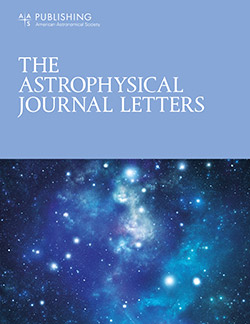First Metis Detection of the Helium D3 Line Polarization in a Large Eruptive Prominence
IF 8.8
1区 物理与天体物理
Q1 ASTRONOMY & ASTROPHYSICS
引用次数: 0
Abstract
Abstract Metis on board Solar Orbiter is the space coronagraph developed by an Italian–German–Czech consortium. It is capable of observing solar corona and various coronal structures in the visible-light (VL) and UV (hydrogen Ly α ) channels simultaneously for the first time. Here we present observations of a large eruptive prominence on 2021 April 25–26, in the VL, taken during the mission cruise phase, and demonstrate that apart from the broadband continuum emission, which is due to the Thomson scattering on prominence electrons, we detect a significant radiation in the neutral-helium D 3 line (587.6 nm), which lies within the Metis VL passband. We show how the prominence looks like in Stokes I , Q , and U . We consider two extreme cases of the prominence magnetic field, and we separate the Stokes I and Q signals pertinent to Thomson scattering and to the D 3 line. The degree of linear polarization of the D 3 line (both Q and U ) indicates the presence of the prominence magnetic field; hence Metis can serve as a magnetograph for eruptive prominences located high in the corona.Metis首次探测到大喷发日珥中的氦D3线偏振
太阳轨道器上的梅蒂斯是由意大利、德国和捷克联合开发的空间日冕仪。首次能够在可见光(VL)和紫外(氢Ly α)通道同时观测日冕和各种日冕结构。在这里,我们展示了2021年4月25日至26日在VL的一个大喷发日珥的观测结果,这是在任务巡航阶段拍摄的,并证明除了宽带连续发射,这是由于汤姆逊散射对日珥电子的影响,我们在梅蒂斯VL通带内的中性氦D 3线(587.6 nm)中检测到显著的辐射。我们展示了在Stokes I, Q和U中突出的样子。我们考虑了日珥磁场的两种极端情况,并分离了与汤姆逊散射和d3线有关的斯托克斯I和Q信号。三维线的线极化度(Q和U)表明日珥磁场的存在;因此,梅蒂斯可以作为位于日冕高处的喷发日珥的磁力计。
本文章由计算机程序翻译,如有差异,请以英文原文为准。
求助全文
约1分钟内获得全文
求助全文
来源期刊

Astrophysical Journal Letters
ASTRONOMY & ASTROPHYSICS-
CiteScore
14.10
自引率
6.30%
发文量
513
审稿时长
2-3 weeks
期刊介绍:
The Astrophysical Journal Letters (ApJL) is widely regarded as the foremost journal for swiftly disseminating groundbreaking astronomical research. It focuses on concise reports that highlight pivotal advancements in the field of astrophysics. By prioritizing timeliness and the generation of immediate interest among researchers, ApJL showcases articles featuring novel discoveries and critical findings that have a profound effect on the scientific community. Moreover, ApJL ensures that published articles are comprehensive in their scope, presenting context that can be readily comprehensible to scientists who may not possess expertise in the specific disciplines covered.
 求助内容:
求助内容: 应助结果提醒方式:
应助结果提醒方式:


